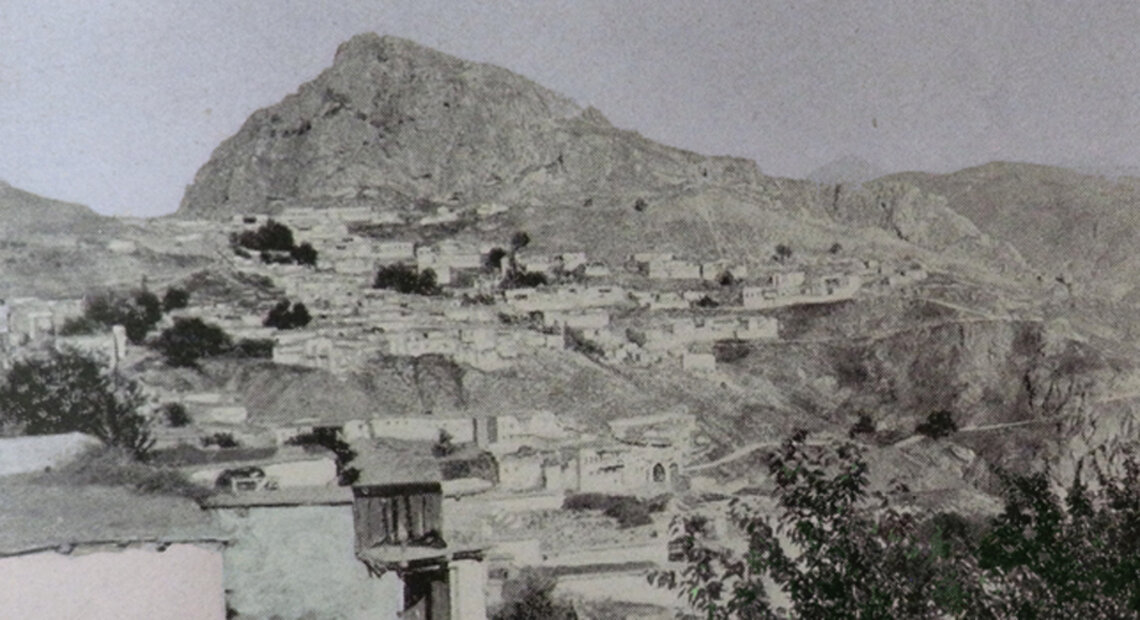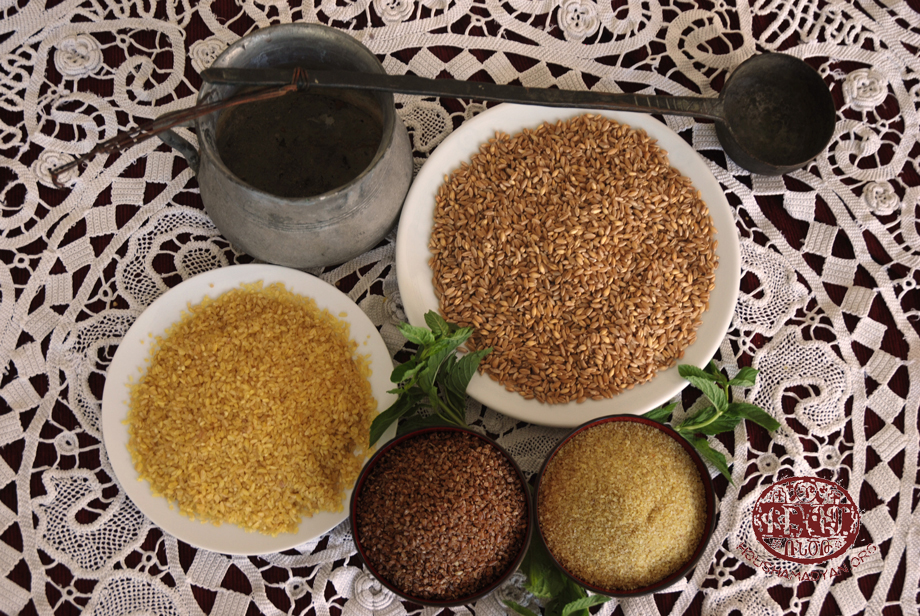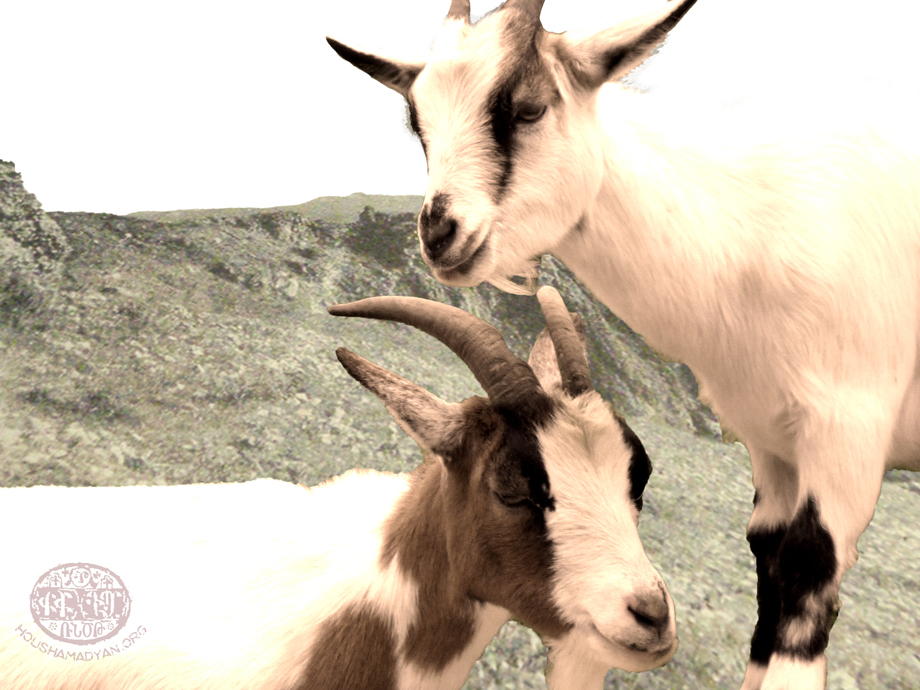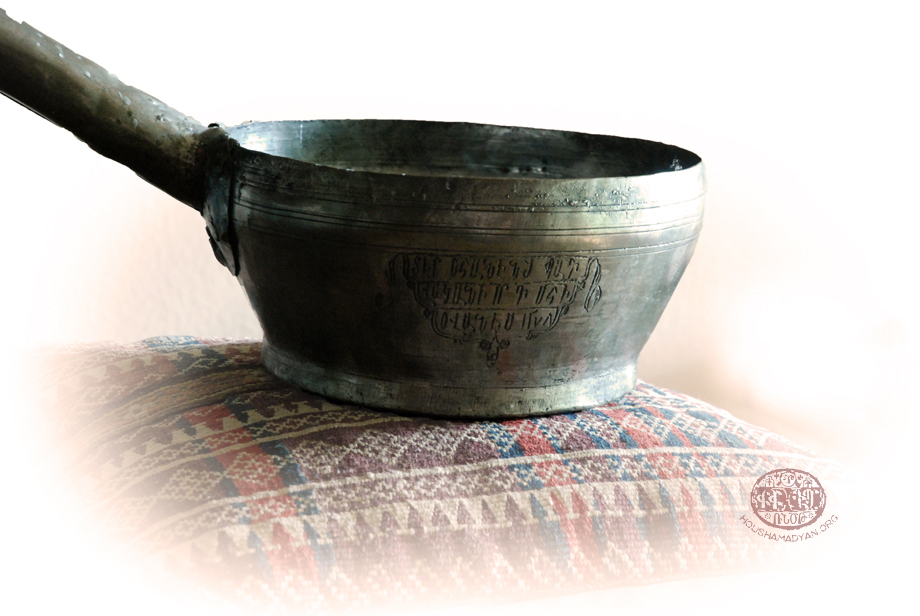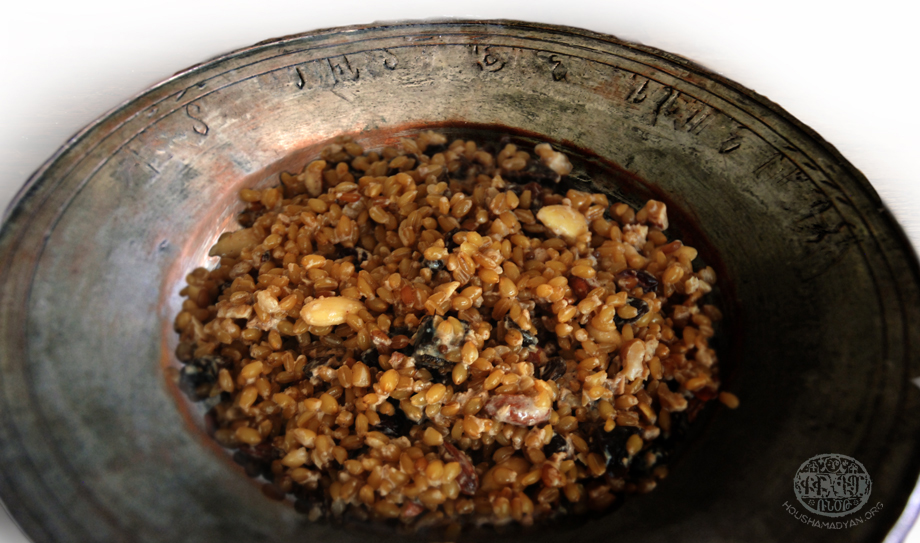Palu - Cuisine
Editorial note
This article about the kinds of food eaten in Palu is taken from Rev Harutiun Sarkisian’s (Alevor) book. We are sure that among our visitors there will be people from Palu or simply those who are familiar with Palu cuisine and know these dishes or sweets. We would ask these people to share their knowledge with us by sending recipies of Palu dishes they know using our e-mail address. The information you send will help our efforts to reconstruct and preserve this culinary legacy.
There are notable differences between the diet of the people of Palu town and that of the surrounding villages. Thus meat, generally mutton or goat, has a central place in the townsman’s kitchen, and is never absent from his daily fare. In village kitchens, on the contrary, vegetables, legumes and dairy products are much more plentiful. The villager keeps many hens. But it is only eggs that are eaten, it being considered to be ‘wrong’ to kill chickens and to prepare meals with its meat. It sometimes happens, however, that a cockerel is sacrificed at the church during a pilgrimage.
The Palu villager does not generally eat meat from March until June. In the latter month the Kurds from the surrounding villages bring kids several months old to the Armenian villages to sell. These animals, cheap to find, are roasted in the oven (tonir). So from June until September, the villager eats fresh meat once a week. From September until the last Sunday of Pun Paregentan in February oxen, cows or buffaloes are slaughtered in the villages on a weekly basis. [1)
Dishes
Here are some general points about dishes in Palu and their preparation:
Raw kufte (meat patties): Kufte is most prepared and best-loved dish made with meat in the whole of Palu district, eaten either raw or roasted. Raw kufte is a mixture of raw, finely chopped meat and bulghur (cracked wheat). They are mixed together such the bulghur becomes soft and sticky. Chopped parsley and onion are also added. [2]
Bulghur pilav: A small amount of meat that has been seared in the oven is cooked with the bulghur. To this is added a few milled chick peas. In the northern part of the district vegetables are often mixed with this dish, for example beans. It is eaten several times a week. The same dish can be cooked with ground wheat (gorgod) or branless wheat (dzedzadz) but this is quite rare. [3]
Sermerdig soup: This is prepared using small bulghur grains, meat and oil. With bulghur pilav it is more liquid and made more during harvest time, bearing in mind that it cools only slowly. During the midday rest members of the family, loaded down with this food, travel for an hour from the village to the fields, giving it to the people bringing in the harvest while it is still hot. [4]
Tanabur (yogurt soup): To a set quantity of cold tan (yogurt and water mixture) add 1/8 of its content of ground wheat (gorgod) or branless wheat (dzedzadz), some oregano and the white of an egg. These are mixed well then the pan is put on the fire to cook, stirring the mixture continuously with a wooden beater (dep sherk) until it begins to boil. Then the stirring is stopped and the fire reduced to a gentle heat. The pan is allowed to simmer for about one hour, until the ground wheat or branless wheat becomes soft. It is then allowed to cool. It is eaten cold as it is easily digested, containing neither fat nor oil. It is a must at as part of the meal eaten on the Saturday before Easter Sunday (the festival of lighting the lamps before Resurrection day). [5]
Tarkhana (Tarhana, with yogurt): A set quantity of cold tan (yogurt and water mixture) and 1/8 of its content of branless wheat is put into a large cauldron and put on a fire until it begins to boil. It must be stirred with a ladle continuously so that the branless wheat and the yogurt and water mixture combine well. Then the cauldron is removed from the fire and allowed to cool. It thickens considerably, and small balls of the mixture are prepared and put out in the sun to dry. [6]
Tarkhana (Tarhana, with water): Ground wheat and water are boiled together. To this mint, parsley and pepper are added. The pan is taken off the fire and, having cooled, is kept for 8 days until the mixture has well and truly thickened. Then small balls of the mixture are prepared and put out in the sun to dry. [7]
Gruel (pokhind or khavidz): Wheat is toasted then milled. The result is a form of flour which is mixed with water and boiled, at the same time adding clarified butter and syrup (roub, pekmez). [8]
Khoris: this is a form of pilav, prepared with fish and bulghur. Generally types of fish with the fewest bones are selected, such as tostos (a kind of fish living in the Euphrates/Aradzani River). Thin pieces of wood are arranged in the bottom of an earthenware pan, on which the gutted and filleted fish is put. The bulghur is then added on top. The pan is then sealed completely with mud and either put on an open fire or in the oven. It must be cooked well. [9]
Chortan abur (dried curd soup): This is a winter dish. It replaces tanabur when it is not possible to have yogurt tan. Dried yogurt tan which, having been melted, is used in the preparation of this soup by mixing it with water. Branless wheat is added to this mixture and boiled. It is an easily digested dish. [10]
Pandjar abur (beet soup): First branless wheat is cooked in water for a short time, and then a quantity of milled lentils is added. After a time white beet is added, the mixture being stirred while cooking. It is eaten with clarified butter or sesame oil. [11]
Perper abur (purslane soup): This dish is prepared in a similar way to pandjar abur. Branless wheat is cooked for a short time, and then a quantity of milled lentils, dry pepper, onions and dried purslane are all added. Cooking continues, the mixture being stirred continuously. It is eaten with clarified butter or sesame oil. [12]
Khoru: Ingredients: bulghur; ground, pounded sesame turned into paste; a little pounded red pepper; chopped onion. All these ingredients are mixed together and put into a saucepan half-full of water, the lid is put on it and sealed with flour so that air cannot enter. Then it is put into the tonir (oven) to boil. [13]
Kufte (patties) made with bulghur and chickpeas: Ingredients: bulghur and triple the amount of chickpeas. This dish greatly resembles the comparatively better known one called topig. [14]
Bahots keshkeg (fasting keshkeg): Ingredients: branless wheat, lentils, chickpeas, dried artichoke, dry vegetables, sesame oil. [15]
Seron: Prepared using thinly rolled dough. It is cut into small pieces, and then dipped completely in yogurt soup flavoured with garlic. It is then put into a deep pan and finally oil is added. [16]
Sweets
General information about sweets eaten in the Palu district and their preparation.
Khoshab (compote): Made from apricots, plums, raisins and concentrated grape juice (roub, pekmez). [17]
Anushabur (sweet soup): Ingredients: water, branless wheat, walnuts, almonds, raisins, honey (sometimes replaced by syrup or manna). The latter is a form of manna that forms on the leaves of trees. It is sweeter than honey. [18]
Shushmayi hats (sesame bread): Ingredients: dough made from wheat flour, rolled very thin and fried in sesame oil. Then each side is coated with a liquid mixture made of sesame oil and pekmez (or honey). When ready, they are piled one on top of another. [19]
Patila: This is a pastry, prepared with wheat flour. First the dough is rolled very thinly and divided into two. Cheese or khawurma is put on the first half and covered with the second. The edges are stuck together then cooked on a saj (an inverted circular metal dish heated by a fire below it). After cooking it is cut into small square pieces and handed round. [20]
Pekhpekhig: A sweet, prepared with flour, egg yolk and milk. It is cooked in oil, and then concentrated grape juice or honey is added on top. Each piece is a little larger than a walnut. [21]
Asida: This is the people of Palu’s herushag (sesame sweet). First pure oil is burnt well in a pan. Then it is mixed with one hand with a circular motion, and flour is gradually dribbled into it with the other. The mixture is continually stirred over a gentle fire, until it is well scorched. A small amount is taken with a spoon and poured onto the roub (pekmez) that is nearby. If a bubbling action begins, then the roub is added to the scorched flour mixture little by little. Stirring continues until all the roub is completely absorbed by the flour. It is then made into little balls. The asida is ready. This sweet is eaten separately but is sometimes mixed with cream, butter or eggs. It is present on the tables set for engagements and marriages. It is also a permanent presence in the gifts (pay) sent to her future in-laws by an engaged girl’s family. When a death occurs this sweet is distributed, this time as a token of mourning to those visiting the deceased person’s home. [22]
Mulberry kesme: This is a sweet made from grdjig mulberries. These are the latest ripening mulberries in the Palu district, remaining on the trees until the end of August. Unlike the other kinds, grdjig mulberries are generally drier, so less dust, soil and prickles stick to it. Once it harvested, it is brought home and spread out on the floor in the shade. After staying there for a few days, the grdjig mulberries dry out and become hard. Then the stalks are removed from each fruit and they are put into storage vessels, where they remain until December. Then they are brought out of the storage vessels and spread out once more, this time on the roof under the sun. After staying like that there for a complete day, they are collected up and milled using a grindstone, such that the whole fruit turns into dust. The resulting powder is called ttalir (tuti alur – mulberry flour). It is then put through a very fine sieve, then into copper tubs, taken up to the roof and put in the sun. After remaining there for a few hours, the flour becomes soft and somewhat sticky. It is then made it into cubes or pieces using a knife. All of the pieces are brought into the house and put into containers. The mulberry kesme is ready. [23]
Grape basdegh (dried grape juice sheets, pestil in Turkish): White grape must is preferred for this. It is boiled in a cauldron, and then a little erbehogh added to the liquid. This makes the unwanted dross to sink to the bottom and leaves the liquid clear. The boiling continues until froth appears on the surface. The lady of the house collects this froth with a ladle and throws it away. This has to continue until no more froth appears. Then, while swiftly stirring it constantly using a ladle with one hand, flour is gradually added. The flour must spread throughout the liquid, and must not form lumps. The prepared mixture is called malez, and in this particular case basdegh (dried grape juice sheets) malez. The cauldron with its contents is taken on to the flat roof where a clean cloth has been spread out. The malez is poured on to the cloth and spread evenly out on it, until it reaches an even thinness and glossiness. The coated cloths remain under the open sky for a number of days, until it is completely set. Then this dry roub (pekmez) is brought into the house, put upside down on a table – in other words with the dried grape juice sheets touching the table surface, with the cloth uppermost. The lady of the house is the main organiser of this work, and has clean water and a ball made of clean rags to hand. She begins to dampen the cloth with the wet ball, such that the dried grape juice sheets gradually come away from it. The separated basdegh is dried for some time, after which it is cut into even squares or triangles, then put into earthenware containers and sealed up with clay. [24]
Djemila: An amount of roub is mixed with half its volume of water and mixed. Pure oil is added to this, then thin pieces of oven (tonir) bread are arranged in the mixture, one on top of the other. After being boiled for a minute or two the mixture becomes thick. It is removed from the fire and the djemila is ready. [25]
Rodjig (cevizli sucuk in Turkish) is prepared from the mixture used to make basdegh. The shells are removed from walnuts and the nuts themselves strung on strings about half a metre long, a little apart, like a necklace. Almonds or kernels of apricot seeds may be used instead. These strings are completely dipped in the malez, then removed and hung up for a short time. Then they are dipped in the malez again and hung up once more. This is repeated three or four times. [26]
Tuti basdegh (mulberry syrup sheets, pestil in Turkish): After cleaning the mulberry roub (syrup) by passing it through a very fine sieve several times, it is put into a cauldron and boiled. The cauldron is kept on the fire until the must thickens and becomes malez. Then the malez is taken up on to the flat roof and spooned onto clean cloths a few metres long and half a metre wide. This is not enough, of course, to make the basdegh thin. So it is necessary to trowel it, until it is as thin as the piece of cloth itself and is glossy. The malez remains outside in this state for a few days, until the liquid part completely sets. Then this dry roub is brought into the house, and separated from the cloth as described for grape basdegh (see above). They are cut into similar size pieces and put into a shallow dish. The pieces are eaten in their plain state, but they can also be fried with oil and eggs. [27]
- [1] Rev Harutiun Sarkisian (Alevor), Palu: its customs, educational and intellectual state and dialect, published by Sahag-Mesrob press, Cairo, 1932, page 243, 245. (In Armenian)
- [2] Ibid., page 245.
- [3 Ibid., page 247. Both gorgod (ground wheat) and dzedzadz (branless wheat) are prepared from the kind of wheat called mandjak, the grains of which are hard and not usually used for making bread.
- [4] Ibid.
- [5] Ibid.
- [6] Ibid., page 247-248.
- [7] Ibid., page 248.
- [8] Ibid.
- [9] Ibid.
- [10] Ibid.
- [11] Ibid., page 249.
- [12] Ibid., pages 13-14, 249.
- [13] Ibid., page 13.
- [14] Ibid.
- [15] Ibid., page 13-14
- [16] Ibid., page 21.
- [17] Ibid., page 13։
- [18] Ibid.
- [19] Ibid., page 14.
- [20] Ibid., page 21.
- [21] Ibid., page 21.
- [22] Ibid., page 171.
- [23] Ibid., page 129-130.
- [24] Ibid., page 172.
- [25] Ibid., page 171
- [26] Ibid., page 174-178.
- [27] Ibid., page 127-128.
